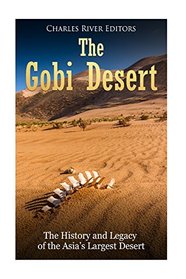The Gobi Desert is a 'cold desert.' I'd never heard that term before. Essentially, it means that the Gobi has hot summers but extremely cold winters. These deserts are found in high, flat areas, called plateaus, or mountainous areas Like other types of desert, cold deserts get very little rain or snow.
The story of the Gobi Desert starts with the myth of the Mongolian Death Worm (or Olgoi-Khorkhoi), which means "intestine worm". The story is quite engrossing (it may even gross you out), but a portion of the population believes in the death-bringing powers of this 2 to 7-foot worm. Some people look at this story as Asia's Bigfoot myth.
With only 7 inches of rain per year, the Gobi still is able to maintain some life and vegetation, specifically a type of camel, bear, pit viper, goats, wild ass, and wild horse (a photo is offered of the camel and wild horse). Only 5% of the Gobi have the waves of sand we're used to seeing. The rest of the Gobi is bare rock.
The photos in this book are amazing; I didn't think the text was nearly as interesting. It seemed to jump around from archaeology to myths, to historical places, to people who might have lived in the Gobi, to the history of Genghis Khan, Kublai Khan, and Marco Polo, to the Mongols, to different Chinese dynasties, the Mogao Caves, and back to current archaeology. I really thought this was a hot mess. This would have been improved by clear section headings and a clear path of explanations (this just seemed to jump from topic to topic).
The story of the Gobi Desert starts with the myth of the Mongolian Death Worm (or Olgoi-Khorkhoi), which means "intestine worm". The story is quite engrossing (it may even gross you out), but a portion of the population believes in the death-bringing powers of this 2 to 7-foot worm. Some people look at this story as Asia's Bigfoot myth.
With only 7 inches of rain per year, the Gobi still is able to maintain some life and vegetation, specifically a type of camel, bear, pit viper, goats, wild ass, and wild horse (a photo is offered of the camel and wild horse). Only 5% of the Gobi have the waves of sand we're used to seeing. The rest of the Gobi is bare rock.
The photos in this book are amazing; I didn't think the text was nearly as interesting. It seemed to jump around from archaeology to myths, to historical places, to people who might have lived in the Gobi, to the history of Genghis Khan, Kublai Khan, and Marco Polo, to the Mongols, to different Chinese dynasties, the Mogao Caves, and back to current archaeology. I really thought this was a hot mess. This would have been improved by clear section headings and a clear path of explanations (this just seemed to jump from topic to topic).




